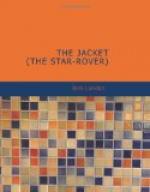“What is it?” my mother asked from within the wagon.
“Water,” was my father’s reply. “It must be Nephi.”
And my mother: “Thank God! And perhaps they will sell us food.”
And into Nephi, through blood-red dust, with grind and grate and jolt and jar, our great wagons rolled. A dozen scattered dwellings or shanties composed the place. The landscape was much the same as that through which we had passed. There were no trees, only scrub growths and sandy bareness. But here were signs of tilled fields, with here and there a fence. Also there was water. Down the stream ran no current. The bed, however, was damp, with now and again a water-hole into which the loose oxen and the saddle-horses stamped and plunged their muzzles to the eyes. Here, too, grew an occasional small willow.
“That must be Bill Black’s mill they told us about,” my father said, pointing out a building to my mother, whose anxiousness had drawn her to peer out over our shoulders.
An old man, with buckskin shirt and long, matted, sunburnt hair, rode back to our wagon and talked with father. The signal was given, and the head wagons of the train began to deploy in a circle. The ground favoured the evolution, and, from long practice, it was accomplished without a hitch, so that when the forty wagons were finally halted they formed a circle. All was bustle and orderly confusion. Many women, all tired-faced and dusty like my mother, emerged from the wagons. Also poured forth a very horde of children. There must have been at least fifty children, and it seemed I knew them all of long time; and there were at least two score of women. These went about the preparations for cooking supper.
While some of the men chopped sage-brush and we children carried it to the fires that were kindling, other men unyoked the oxen and let them stampede for water. Next the men, in big squads, moved the wagons snugly into place. The tongue of each wagon was on the inside of the circle, and, front and rear, each wagon was in solid contact with the next wagon before and behind. The great brakes were locked fast; but, not content with this, the wheels of all the wagons were connected with chains. This was nothing new to us children. It was the trouble sign of a camp in hostile country. One wagon only was left out of the circle, so as to form a gate to the corral. Later on, as we knew, ere the camp slept, the animals would be driven inside, and the gate-wagon would be chained like the others in place. In the meanwhile, and for hours, the animals would be herded by men and boys to what scant grass they could find.
While the camp-making went on my father, with several others of the men, including the old man with the long, sunburnt hair, went away on foot in the direction of the mill. I remember that all of us, men, women, and even the children, paused to watch them depart; and it seemed their errand was of grave import.




